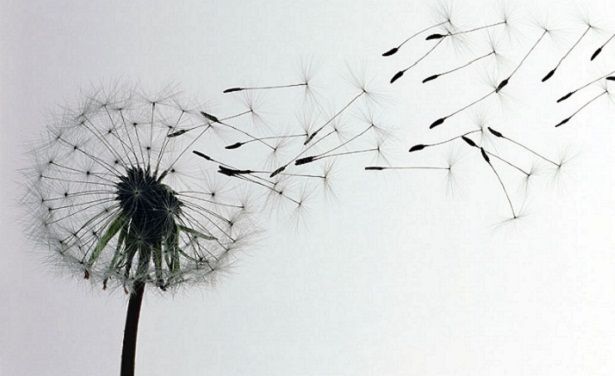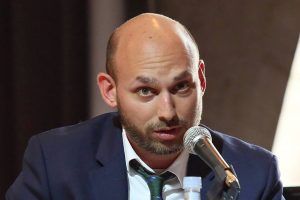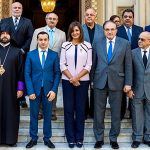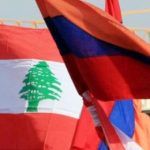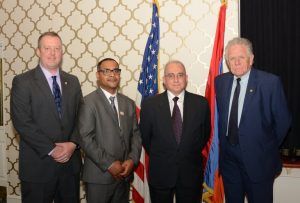Anna Shmavonian: “Armenians in Kuwait are “thirsty” for culture…”

Kuwait’s Shakeh Dance Ensemble participated in the 2nd “My Armenia” Pan-Armenian Festival for the first time. The ensemble’s artistic director is Anna Shmavonian. During the meeting, “Hayern Aysor”’s correspondent found out that Anna also teaches at the National School of Kuwait, and that was exactly the first topic of the interview.
Anna Shmavonian: I’ve been living abroad for 21 years. First, I settled in Syria, but after my husband, Manouk Manoukian received a job offer, we moved to Kuwait. My husband is the principal of the only Armenian school in Kuwait, and I teach Armenian.
“Hayern Aysor”: Could you tell us a little about the school?
A. S.: The National School of Kuwait (kindergarten, secondary school, lyceum) has 485 students with instruction in three languages, including Armenian, Arabic and English. The level of education is very high, and our students go on to study at the world’s top universities.
There are nearly 4,000 Armenians living in Kuwait. The children mainly attend Armenian schools. There aren’t many Armenian children attending international schools.
“Hayern Aysor”: What is the story behind Shakeh Dance Ensemble?
A. S.: I had a dance ensemble in Aleppo. When we moved to Kuwait, I wanted to create a new one. As you know, rumors spread fast. I was offered to create a dance group, and I couldn’t turn down the offer. The Armenians in Kuwait are “thirsty” for culture, but there are no figures that can help raise the level of culture.
The Shakeh Dance Ensemble has been around for the past seven years. In the beginning, it was a large dance ensemble with nearly 40 male and female dancers. Now, due to a turnover, it’s an all-girls ensemble. The members are replaced often. The young Armenians are like the elders of Kuwait. Many travel to foreign countries for study purposes, meaning we lose several dancers every year. This year, we decided to hold rehearsals with only female dancers.
I hope next year the dance ensemble will be co-ed once again. The boys who left for study will return next year.
“Hayern Aysor”: How did you come up with the name for the ensemble?
A. S.: The dance ensemble is part of the ARS Kuwait Chapter. Our founder was the chairwoman of the ARS, who supported and encouraged me a lot. Unfortunately, she passed away during our first performance, and we named the dance ensemble Shakeh in her honor.
“Hayern Aysor”: Do you give concerts often?
A. S.: Yes, we give a year-end concert every year. We always perform new and beautiful dances.
“Hayern Aysor”: Is this your first time performing outside of Kuwait?
A. S.: Yes, we only performed once in Abu Dhabi. It was very touching to perform in Armenia for the first time. We had been waiting for it a lot. We were a little afraid and nervous, but it turned out to be a success.
The festival brought together the members of dance ensembles from different countries. In Kuwait we don’t have any ties with the other communities and have never had the chance to compare our dance ensemble with other dance ensembles. I’m very pleased with the fact that we had this opportunity in Armenia.
We found out about the festival by chance. A friend of one of our dancers, who lives in Australia, told us that her dance ensemble was going to be participating in a festival in Armenia in the summer. Our girls got very excited and said they wanted to participate. We contacted the organizers of the “My Armenia” Pan-Armenian Festival and are grateful to them for paying heed to our request. We’re very happy that we had the chance to participate in the festival. New things and experiences are very important for a dance ensemble.
“Hayern Aysor”: Did you have the chance to establish contacts with other dance ensembles?
A. S.: This might sound strange, but we didn’t have the chance because of the language barrier. Most of the members speak Russian. The children would ask me why they were asked to speak Armenian when the others were speaking Russian, and I didn’t know what to say. In Arab countries we try to make sure our children don’t lose knowledge of the Armenian language, but Armenians in Russia and Ukraine lose knowledge very quickly.
I expressed my concern during the master classes and asked the dance instructors to not only teach the children dances, but also urge them to speak only in Armenian with each other.
It was very interesting for my girls to become friends and communicate with their peers, but they weren’t able to communicate with many Armenian-speaking dancers and remained isolated.
We have to think about this. It’s very painful to see our children forgetting their native language.
Interview by Lusine Abrahamyan




 Արևելահայերեն
Արևելահայերեն Արևմտահայերեն
Արևմտահայերեն Русский
Русский